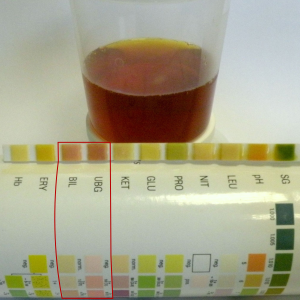Choluria
| Choluria | |
|---|---|
 | |
| Choluria. Urine test strip shows a high levels of the bilirubin and urobilinogen. | |
| Specialty | Gastroenterology |
Choluria is the presence of bile in urine.[1] Choluria is a common symptom of liver diseases, such as hepatitis and cirrhosis. It can be described as dark or brown urine, often referred to as the color of Coca-Cola. Choluria is usually manifested when serum bilirubin is higher than 1.5 mg/dL. The presence of choluria is a useful symptom to distinguish if somebody presenting with jaundice has liver disease (direct hyperbilirubinemia) or hemolysis (indirect hyperbilirubinemia). In the first case, patients have choluria due to excess conjugated ("direct") bilirubin in blood, which is eliminated by kidneys. Hemolysis, on the contrary, is characterized by unconjugated ("indirect") bilirubin which is bound to albumin and thus not eliminated in urine.[citation needed]
See too[]
References[]
External links[]
| Classification |
|---|
- Urinary bladder disorders